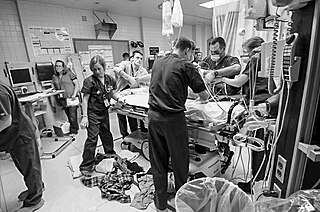Related Research Articles

Emergency medicine is the medical speciality concerned with the care of illnesses or injuries requiring immediate medical attention. Emergency physicians specialise in providing care for unscheduled and undifferentiated patients of all ages. As first-line providers, in coordination with emergency medical services, they are primarily responsible for initiating resuscitation and stabilization and performing the initial investigations and interventions necessary to diagnose and treat illnesses or injuries in the acute phase. Emergency physicians generally practise in hospital emergency departments, pre-hospital settings via emergency medical services, and intensive care units. Still, they may also work in primary care settings such as urgent care clinics.
In the United States, a health maintenance organization (HMO) is a medical insurance group that provides health services for a fixed annual fee. It is an organization that provides or arranges managed care for health insurance, self-funded health care benefit plans, individuals, and other entities, acting as a liaison with health care providers on a prepaid basis. The Health Maintenance Organization Act of 1973 required employers with 25 or more employees to offer federally certified HMO options if the employer offers traditional healthcare options. Unlike traditional indemnity insurance, an HMO covers care rendered by those doctors and other professionals who have agreed by contract to treat patients in accordance with the HMO's guidelines and restrictions in exchange for a steady stream of customers. HMOs cover emergency care regardless of the health care provider's contracted status.

Primary care is the day-to-day healthcare given by a health care provider. Typically this provider acts as the first contact and principal point of continuing care for patients within a healthcare system, and coordinates other specialist care that the patient may need. Patients commonly receive primary care from professionals such as a primary care physician, a chiropractor,a physician assistant, a physical therapist, or a nurse practitioner. In some localities, such a professional may be a registered nurse, a pharmacist, a clinical officer, or an Ayurvedic or other traditional medicine professional. Depending on the nature of the health condition, patients may then be referred for secondary or tertiary care.
The term managed care or managed healthcare is used in the United States to describe a group of activities intended to reduce the cost of providing health care and providing American health insurance while improving the quality of that care. It has become the predominant system of delivering and receiving American health care since its implementation in the early 1980s, and has been largely unaffected by the Affordable Care Act of 2010.
...intended to reduce unnecessary health care costs through a variety of mechanisms, including: economic incentives for physicians and patients to select less costly forms of care; programs for reviewing the medical necessity of specific services; increased beneficiary cost sharing; controls on inpatient admissions and lengths of stay; the establishment of cost-sharing incentives for outpatient surgery; selective contracting with health care providers; and the intensive management of high-cost health care cases. The programs may be provided in a variety of settings, such as Health Maintenance Organizations and Preferred Provider Organizations.
In U.S. health insurance, a preferred provider organization (PPO), sometimes referred to as a participating provider organization or preferred provider option, is a managed care organization of medical doctors, hospitals, and other health care providers who have agreed with an insurer or a third-party administrator to provide health care at reduced rates to the insurer's or administrator's clients.
The University of North Texas Health Science Center is a public academic health science center in Fort Worth, Texas. It is part of the University of North Texas System and was founded in 1966 as the Texas College of Osteopathic Medicine, with its first cohort admitted in 1970. UNT Health Science Center consists of six schools with a total enrollment of 2,329 students (2020–21).

A paramedic is a healthcare professional, providing pre-hospital assessment and medical care to people with acute illnesses or injuries. In Canada, the title paramedic generally refers to those who work on land ambulances or air ambulances providing paramedic services. Paramedics are increasingly being utilized in hospitals, emergency rooms, clinics and community health care services by providing care in collaboration with registered nurses, registered/licensed practical nurses and registered respiratory therapists.

Health human resources (HHR) – also known as human resources for health (HRH) or health workforce – is defined as "all people engaged in actions whose primary intent is to enhance positive health outcomes", according to World Health Organization's World Health Report 2006. Human resources for health are identified as one of the six core building blocks of a health system. Human resources for health include physicians, nursing professionals, pharmacists, midwives, dentists, allied health professions, community health workers, social health workers and other health care providers, as well as health management and support functions personnels like cleaner, guard etc. who add important values as part of the wider health systems so that enhance the delivery of essential healthcare services effectively and efficiently. Effective health system functioning highly demand well trained health services managers, medical records and health information technicians, health economists, health supply chain managers, medical secretaries and others.

A primary care physician (PCP) is a physician who provides both the first contact for a person with an undiagnosed health concern as well as continuing care of varied medical conditions, not limited by cause, organ system, or diagnosis. The term is primarily used in the United States. In the past, the equivalent term was 'general practitioner' in the US; however in the United Kingdom and other countries the term general practitioner is still used. With the advent of nurses as PCPs, the term PCP has also been expanded to denote primary care providers.
Interprofessional education refers to occasions when students from two or more professions in health and social care learn together during all or part of their professional training with the object of cultivating collaborative practice for providing client- or patient-centered health care.

Bernard Lown was a Lithuanian-American cardiologist and inventor. Lown was the original developer of the direct current defibrillator for cardiac resuscitation, and the cardioverter for correcting rapid disordered heart rhythms. He introduced a new use for the drug lidocaine to control heartbeat disturbances.
Concierge medicine, also known as retainer medicine, is a relationship between a patient and a primary care physician in which the patient pays an annual fee or retainer. In exchange for the retainer, doctors agree to provide enhanced care, including commitments to ensure adequate time and availability for each patient.

Physician supply refers to the number of trained physicians working in a health care system or active in the labor market. The supply depends primarily on the number of graduates of medical schools in a country or jurisdiction but also on the number continuing to practice medicine as a career path and remaining in their country of origin. The number of physicians needed in a given context depends on several different factors, including the demographics and epidemiology of the local population, the numbers and types of other health care practitioners working in the system, and the policies and goals in place of the health care system. If more physicians are trained than needed, supply exceeds demand. If too few physicians are trained and retained, some people may have difficulty accessing health care services. A physician shortage is a situation in which there are not enough physicians to treat all patients in need of medical care. That can be observed at the level of a given health care facility, a province/state, a country, or worldwide.
The Community Oncology Alliance (COA) is a non-profit organization in the United States that advocates for patients with cancer and their providers in the independent, community oncology setting. There are more than 6,500 providers at 950 community cancer clinics that treat the majority of Americans with cancer.
There were a number of different health care reforms proposed during the Obama administration. Key reforms address cost and coverage and include obesity, prevention and treatment of chronic conditions, defensive medicine or tort reform, incentives that reward more care instead of better care, redundant payment systems, tax policy, rationing, a shortage of doctors and nurses, intervention vs. hospice, fraud, and use of imaging technology, among others.

Paul Grundy is an American physician known as the "godfather" of the Patient Centered Medical Home. He was named a member of the Institute of Medicine, and recipient of the Barbara Starfield Primary Care Leadership Award and the 2012 National Committee for Quality Assurance(NCQA) Quality Award.

Yvette Roubideaux is an American doctor and public health administrator. She is a member of the Rosebud Sioux Tribe of South Dakota.

The Academy of Family Physicians of India (AFPI) is a professional academic society, registered as a non-profit organization in India. AFPI has been founded with the aim of promoting family medicine and primary healthcare. Family medicine is the practicing speciality and academic discipline of majority Indian doctors. Although there were GP associations such as IMA CGP and FFPAI have been existing for several decades, there was no forum for spearheading development of academic family medicine in India. AFPI is an equivalent organization to American Academy of Family Physicians, College of Family Physicians of Canada, Royal College of General Practitioners, Royal Australian College of General Practice for India.

Uché Blackstock is an American emergency physician and former associate professor of emergency medicine at the New York University School of Medicine. She is the founder and CEO of Advancing Health Equity, which has a primary mission to engage with healthcare and related organizations around bias and racism in healthcare with the goal of mobilizing for health equity and eradicating racialized health inequities. During the COVID-19 pandemic Blackstock used social media to share her experiences and concerns as a physician working on the front lines and on racial health disparities and inequities exposed by the pandemic. She is best known for her work amplifying the message on racial health inequities and her media appearances speaking on the COVID-19 pandemic. She has been featured on Meet the Press, PBS NewsHour, Slate and Forbes among others. Blackstock became a Yahoo! News Medical Contributor in June 2020.
References
- ↑ "Remaking Primary Care: From Crisis to Opportunity" (PDF). Network for Excellence in Health Innovation. April 2009.
- 1 2 3 "A new Center for Primary Care". Harvard Gazette. October 28, 2010.
- ↑ "Student Hotspotting Mini-Grant Project". Association of American Medical Colleges.
- ↑ "Primary Care Progress on CNN". CNN. 2010.
- ↑ "Primary Care Progress Engages Trainees in Transformation of Primary Care". American College of Physicians. February 2011.
- ↑ "It's time for a primary care workforce surge". KevinMD.com. March 20, 2012.
- ↑ "Reviving the Pipeline: A Call to Action For All". The Health Care Blog. August 11, 2012.
- ↑ "Luring Students Into Family Medicine". The New York Times. September 9, 2012.
- ↑ "Why We Need Robust Primary Care in the US, and What Congress Can Do to Help". March 12, 2013.
- ↑ "Newly insured to deepen primary care doctor gap". Associated Press. June 22, 2013.
- ↑ "Future of primary care: Who will take care of you?". Association of Health Care Journalists. May 16, 2013.
- ↑ "Grassroots Group Aims to Renew Primary Care". MedPage Today. May 24, 2014.
- ↑ "Why I'm Becoming a Primary-Care Doctor". The Atlantic. September 18, 2014.
- ↑ "The Path To Primary Care: Who Will Be The Next Generation Of Frontline Doctors". New England Public Radio. January 20, 2015.
- ↑ "Raising The Stakes For Primary Care: Advocates Try To Make Field More Attractive". New England Public Radio. January 23, 2015.